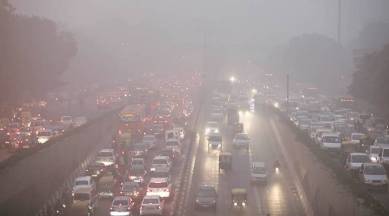Stay updated with the latest - Click here to follow us on Instagram
Diwali celebrations: Air and noise pollution levels rise in Mumbai
The Air Quality Index (AQI) readings obtained from the System of Air Quality Forecast and Research (SAFAR) stated that Mumbai’s AQI value Tuesday was 305 (‘Very Poor’ category).

In the wake of Diwali celebrations, air and noise pollution levels deteriorated in several areas of Mumbai.
The Air Quality Index (AQI) readings obtained from the System of Air Quality Forecast and Research (SAFAR) stated that Mumbai’s AQI value Tuesday was 305 (‘Very Poor’ category).
According to the AQI monitoring chart, an AQI between 0-50 is termed as ‘Good’, between 51-100 is considered ‘Satisfactory’, 101-200 is termed ‘Moderate’, 201-300 is ‘Poor’, 301-400 is ‘Very Poor’ and an AQI beyond 400 is labelled as ‘Severe’.
Data also showed that the primary constituents were PM2.5 components, which are air particulate matters that have a diameter of less than 2.5 micrometers. The PM2.5 components comprise burn residues and dust particles mainly emitted from firecrackers.
On Tuesday, the SAFAR dashboard showed that Malad recorded the worst AQI of 388, followed by an AQI of 363 in Andheri and an AQI of 322 in Chembur.
The AQI in most other parts of Mumbai remained in the poor category. At Worli, however, the readings showed a ‘Satisfactory’ AQI of 58.
Experts attributed the poor AQI to the withdrawal of the monsoon, in addition to the ongoing festive season.
Dr Gufran Beig, senior scientist and founder project director at SAFAR, said the withdrawal of the southwest monsoon has slowed down the airspeed, leading to a phenomenon called ‘Stagnation Condition’.
“For the last two days, people have been bursting crackers due to Diwali. This year, the celebrations were intense since there was no celebration due to Covid-19 in the past two years. Therefore, owing to the firecrackers and stagnant air condition, the accumulation of suspended particulate matter in the air has increased, which has resulted in a decline in the overall air quality,” Beig told indianexpress.com. He said the ‘Stagnant Condition’ will continue for the next week.
“Most firecrackers are being burnt between 9 pm and 12 am, therefore the AQI of Mumbai worsened after 1 am. If further emission doesn’t take place today (Tuesday), then the situation may start improving gradually from tomorrow,” Beig added.
Health experts have advised members from vulnerable groups to use N-95 masks while stepping out.
“After the pandemic-induced lockdown was eased, the number of people suffering from lung-related diseases has increased. This has happened mainly because of an increase in vehicular emissions. Now with the ongoing festive season, the quality of air has worsened due to firecrackers. Therefore, we are advising senior citizens and children to not step out without wearing an N95 mask, even if they are going out for a brief period,” said Dr Sanjeev Mehta, a pulmonologist from Lilavati hospital.
Meanwhile, the noise pollution level in Mumbai also breached the 100 decibel (dB) mark on the day of Diwali.
According to a report prepared by Awaaz Foundation, Mumbai, 103.4 dB was recorded at the Shivaji Park grounds around 9:45 pm Monday, while 108 dB was recorded around 12 am.
The noise levels recorded between 10:30 pm and 11:45 at Marine Drive was 109.1 dB.
“Crackers are permitted to be burst up to 10 pm under the Noise Rules and Court Orders. Though no crackers containing toxic chemicals are permitted under Supreme Court Orders, their presence was detected in a separate test and heavy smoke filled the air at sites where crackers were burst on Diwali night,” the report said.
Sumaira Abdulali, the founder of the Awaaz Foundation, said while the decibel level breached the 100 (dB) mark, it did not surpass pre-Covid levels. In Diwali 2019, for instance, a noise level of 112.3 dB was recorded.
“The decibel level of the firecrackers has declined. Before Diwali, we had done a test on this and the readings we have taken completely justify that. However, the usage of toxic chemicals in manufacturing crackers is still happening and crackers were burst in some of the residential and silence zones of Mumbai till late at night on Diwali,” said Abdulali.
“The Shivaji Park is a silent zone and Marine Drive is also a residential area. Yet, high decibel levels of noise due to firecrackers were recorded from both these places till late night on Monday,” Abdulali added.